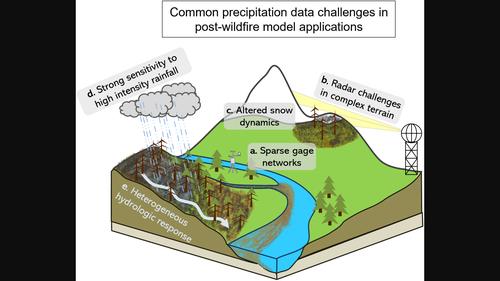Opportunities and challenges for precipitation forcing data in post‐wildfire hydrologic modeling applications
引用次数: 0
Abstract
The frequency and extent of wildfires have increased in recent decades with immediate and cascading effects on water availability in many regions of the world. Precipitation is used as primary input to hydrologic models and is a critical driver of post‐wildfire hydrologic hazards including debris flows, flash floods, water‐quality effects, and reservoir sedimentation. These models are valuable tools for understanding the hydrologic response to wildfire but require accurate precipitation data at suitable spatial and temporal resolutions. Wildfires often occur in data‐sparse, headwater catchments in complex terrain, and post‐wildfire hydrologic effects are particularly sensitive to high‐intensity, short‐duration precipitation events, which are highly variable and difficult to measure or estimate. Therefore, the assessment and prediction of wildfire‐induced changes to watershed hydrology, including the associated effects on ecosystems and communities, are complicated by uncertainty in precipitation data. When direct measurements of precipitation are not available, datasets of indirect measurements or estimates are often used. Choosing the most appropriate precipitation dataset can be difficult as different datasets have unique trade‐offs in terms of spatial and temporal accuracy, resolution, and completeness. Here, we outline the challenges and opportunities associated with different precipitation datasets as they apply to post‐wildfire hydrologic models and modeling objectives. We highlight the need for expanded precipitation gage deployment in wildfire‐prone areas and discuss potential opportunities for future research and the integration of precipitation data from disparate sources into a common hydrologic modeling framework.This article is categorized under:

野火后水文建模应用中降水强迫数据的机遇与挑战
近几十年来,野火发生的频率和范围不断增加,对世界许多地区的水供应产生了直接和连带的影响。降水是水文模型的主要输入,也是野火后水文危害(包括泥石流、山洪、水质影响和水库沉积)的关键驱动因素。这些模型是了解野火水文响应的宝贵工具,但需要具有适当空间和时间分辨率的准确降水数据。野火通常发生在数据稀少、地形复杂的上游集水区,野火后的水文效应对高强度、短时降水事件特别敏感,而这些降水事件变化很大,难以测量或估算。因此,由于降水数据的不确定性,评估和预测野火引起的流域水文变化(包括对生态系统和群落的相关影响)变得更加复杂。在无法直接测量降水量时,通常会使用间接测量或估算的数据集。选择最合适的降水数据集可能很困难,因为不同的数据集在时空精度、分辨率和完整性方面有独特的权衡。在此,我们概述了与不同降水数据集相关的挑战和机遇,因为它们适用于野火后水文模型和建模目标。我们强调了在野火易发地区扩大降水测量仪部署的必要性,并讨论了未来研究的潜在机遇以及将不同来源的降水数据整合到一个共同的水文建模框架中:水科学 > 水文过程 水科学 > 水方法 水科学 > 水与环境变化
本文章由计算机程序翻译,如有差异,请以英文原文为准。
求助全文
约1分钟内获得全文
求助全文

 求助内容:
求助内容: 应助结果提醒方式:
应助结果提醒方式:


